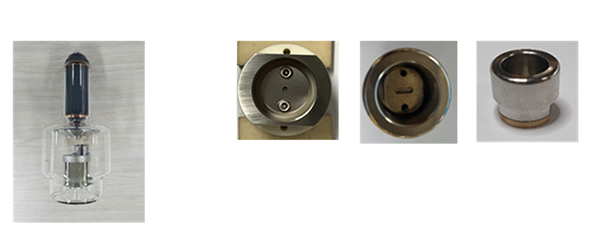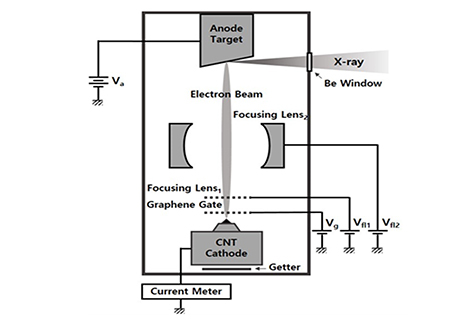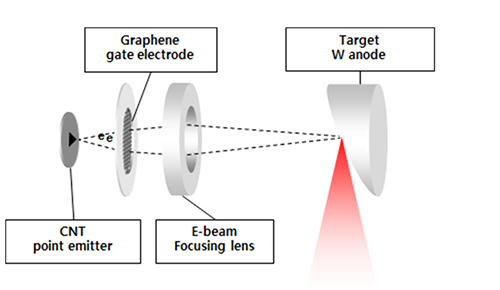New technology developed to change the paradigm of 120-year-old X-ray technology
Development of the world's first nanomaterial-based high performance cold cathode X-ray tube technology
Research results from Professor Cheol-jin Lee’s undivided dedication of 20 years
4 U.S. patent registrations, 3 U.S. patent applications, 5 domestic patent registrations and 1 domestic patent application

▲ Professor Cheol-jin Lee (College of Engineering, School of Electrical Engineering)
Just as LED lamps have replaced conventional light bulbs that have been in use for over a century, nanomaterial-based cold cathode X-ray tubes could be a new technology that replaces one which has been used for the last 120 years, filament-based hot cathode X-ray tubes.
Prof. Cheol-jin Lee’s research team presented their research results concerning nanomaterial-based high performance cold-cathode X-ray tube technology at the 32nd International Vacuum Nanoelectronics Conference (IVNC 2019) held in July in Cincinnati, Ohio.
Instead of heating the filament used in the conventional hot cathode X-ray tube to a high temperature to emit an electron beam, the nanomaterial-based cold cathode X-ray tube researched and developed by Prof. Lee uses a unique method of efficiently emitting high-density electron beams by applying electric fields to carbon nanotubes and graphene.. This is a new way of generating high quality X-rays. These cold cathode X-ray tubes are the world’s first to be researched and developed. In relation to this research, Prof. Lee has already registered 4 U.S. patents, competed applications for 3 U.S. patents, registered 5 domestic patents and completed an application for 1 domestic patent.

▲ Photograph of the world’s first nanomaterial-based cold cathode X-ray tube and related components researched and developed by the research team led by Prof. Lee
Compared to conventional hot cathode X-ray tubes widely used in various fields as medical, non-destructive testing, security screening and sterilization devices, nano-based cold cathode X-ray tubes are capable of operating at high temperatures while consuming less energy, generating high-density X-rays, and enabling better control of the X-ray dosage. They are expected to be the next generation X-ray tube technology, one that will supplant hot cathode X-ray tubes.
This nano-based cold cathode X-ray technology is considered a new innovative technology that has not yet been realized in developed countries such as the U.S., Germany and Japan, which researched and developed hot cathode X-ray tubes 120 years ago.
X-ray medical devices (X-ray diagnostic devices, CTs, etc.) account for about 60% of all medical imaging devices. The global market for X-ray medical devices was $39 billion in 2016 and is expected to grow to $48 billion by 2022. (Reference; Evaluate 2017. 9). With over a hundred years of technology accumulation respectively, GE in the U.S., Siemens in Germany and Philips in the Netherlands are considered the leaders in terms of hot cathode X-ray tube technology. X-ray tubes are used in medical diagnostic or non-destructive testing devices. However, these companies use X-ray tubes only in their own medical diagnostic or non-destructive testing devices and do not make them available to other manufactures in order to protect their intellectual property as the market for commercialized hot cathode X-ray tubes is currently estimated to be worth about $4 billion annually. High performance, high-priced CT X-ray tubes are almost totally monopolized by the U.S. company, Varian (which recently became Varex) with Japan's Toshiba (recently changed to Canon) holding 95% of the market for general purpose mid-priced X-ray tubes. China’s Kailong holds most of the market for low-priced X-ray tubes. On the other hand, Korean X-ray tube makers are small venture companies whose technological level is still far behind that of the leaders, generating only about 1 to 2 billion Korean won in sales annually.
The X-ray apparatus widely used today all use a filament-based hot cathode X-ray source based on hot electron emission. However, these hot electron emission sources are problematic—their electron beam transmission efficiency and resolution are difficult to improve, their operating speed is slow and their lifespan is short due to the wide electron energy distribution and large dispersion of the electron beam. On the other hand, because the new concept of a cold cathode electron emission source based on electric field emission can operate at a high temperature, control electron beam density, generate a short pulse electron, be miniaturized, requires low operating voltage and has a high emission current value, it is now possible to better implement high quality X-ray images and 3D X-ray images.

▲ Schematic of a nanomaterial-based cold cathode X-ray tube researched and developed
by the research team led by Prof. Lee
Regarding the hot cathode X-ray tube technology commercially available and widely used today, the difference in the technical levels of domestic and leading foreign manufacturers is so large that it is difficult to overcome. However, for cold cathode X-ray tube technology, which has attracted much attention recently, domestic research groups are showing comparatively superior R & D achievements compared to those in advanced countries, such as the U.S., Japan and Germany. Particularly in cold-cathode X-ray tube technology using carbon nanotubes as an electron emission source, the research results of domestic research groups far exceed those of foreign research groups.
Prof. Lee's research team’s most noteworthy achievement is that for the first time, new nanomaterials, carbon nanaotubes and graphene were used together as electron emission sources and gate electrodes to emit high density electron beams at a high temperature, and a cold cathode X-ray tube that can emit high-quality X-rays that can be induced and dose controlled was implemented.
Specifically, the results of the research are as follows. First, as a way to overcome the limitations of the thermionic emission source and the existing carbon nanotube electron emission source, a carbon nanotube electron emission source is fabricated using a unique structure and method that is different from the carbon nanotube paste manufacturing method and that greatly improves the density of the electron beam emitted compared to other electron emission sources. Carbon nanotube paste emitters use organic materials that act as contaminants. On the other hand, Prof. Lee’s team shaped carbon nanotubes into a several micrometers thick film with a high-density network to make point-type or line-type electron emission sources, which greatly improved the electron emission current characteristics of the electron emission sources. Second, by using graphene that has an electron beam passage aperture of several nanometers as the gate electrode instead of the conventional metal mesh or metal hole-type gate electrode having an aperture of several hundred micrometers, the team was able to implement a cold cathode X-ray technology that maximizes the linearity and transmittance of the emitted electron beam, controls the X-ray dosage, and has excellent X-ray generation efficiency. According to the research results, the cold cathode X-ray tube was able to greatly increase emission current density to ~ 100 A/cm2 compared to the ~ 1 A/cm2 of a conventional X-ray tube and to significantly improve the electron beam transmittance to 95% compared to 80% for conventional X-ray tubes. It also showed excellent efficiency compared to existing hot cathode and cold cathode X-ray tubes.

▲ A schematic diagram of the method for fabricating point- and line-type carbon nanotube electron
emission sources and a graphene gate electrode for use with cold cathode X-ray tubes
Prof. Lee's research team possesses original technology and patents for developing carbon nanotubes and graphene materials used in cold cathode X-ray tubes and have previously secured a number of domestic and international patents for core components such as emitters, gate electrodes and focusing electrodes that comprise cold cathode X-ray tubes. As a result, Korea’s technological inferiority in hot cathode X-Ray tube technology has been overcome by developing original core technology related to basic materials, components and devices of next generation cold cathode X-ray tubes. Furthermore, by leading the world in the field of cold cathode X-ray tube technology, the gap between foreign research groups will be widened, and original and core base technologies in X-ray tube and X-ray tube application technology are expected to be secured.
Regarding these recent achievements, Prof. Lee reflected on his commitment to researching the electron emission characteristics of carbon nanotubes for more than 20 years, emphasizing that is accomplishments would not have been possible without the zealous efforts and participation of Korea University’s School of Electrical Engineering graduate students. Research into nanomaterial-based cold cathode X-ray tube technology started in 1998 with the study of carbon nanotube synthesis and field electron emission characteristics, the synthesis and electrical properties of graphene, and carbon nanotube electron emission sources and X-ray sources. During his 20 years of research efforts, Prof. Lee has authored 202 international SCI papers, earned 12,675 international citations (h-index 63, i10-index 141), presented at 220 international conferences, registered 18 international patents and applied for 3 international patents, and registered 60 domestic patents and applied for 1 domestic patent.
Nanomaterial-based cold cathode X-ray sources capable of high temperatures, high speeds, low power needs and high doses are used for non-destructive testing devices for semiconductor chips and precision machinery, security and safety screening devices, and food and products, as well as in medical diagnostic devices such as X-rays and CTs. They are expected to be widely used in various applications such as inspection devices, water and food sterilizers, and static electricity and fine dust removal devices. In the future, it is expected that domestic companies in related fields will secure international technological competitiveness in various X-ray application technologies and create and secure high value-added new markets.
The results from this research were achieved through funding from the Ministry of Trade, Industry, and Energy's Nanomaterial Parts Research Support Project and the Ministry of Science and ICT’s Basic Research Project.

▲ Schematic of a nanomaterial-based cold-cathode X-ray tube researched and developed
by the research team led by Prof. Cheol-jin Lee



